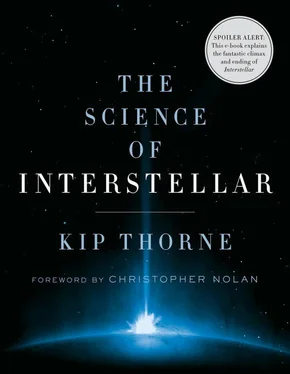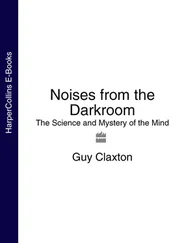Physicists have put great effort into searching for such anomalies on Earth, beginning with Isaac Newton himself in the late 1600s. Those searches have produced many claimed anomalies, but all claims, upon deeper scrutiny, have collapsed.
The anomalies in Interstellar are startling for their weirdness and strength, and the way they change as time passes. If anything like them had occurred in the twentieth century or early twenty-first, physicists would surely have noticed them and explored them with great fervor. Somehow, gravity on Earth has been altered in the era of Interstellar .
And, indeed, Romilly tells Cooper so in the movie: “We started detecting gravitational anomalies [on Earth] almost fifty years ago,” and also, around that same time, the most signficant anomaly of all: the sudden appearance of a wormhole near Saturn, where before there was none.
In the movie’s opening scene, Cooper experiences an anomaly himself, while trying to land a Ranger spacecraft. “Over the Straights something tripped my fly-by-wire,” he tells Romilly.
The GPS system that Cooper has adapted to control harvesting machines, as they roam through corn fields, has also gone haywire, and a bunch of harvesters have converged on his farmhouse. He attributes this to gravitational anomalies that screwed up the gravity corrections that any GPS system relies on (Figure 4.2).
Early in the movie, we see Murph watch, transfixed, as dust falls unnaturally fast to the floor of her bedroom, collecting in a bar-code-like pattern of thick lines. And then we see Cooper stare at the lines (Figure 24.5) and toss a coin across one. The coin shoots to the floor.

Fig. 24.5. Cooper stares at the dust pattern on the floor of Murph’s bedroom. [From Interstellar , used courtesy of Warner Bros. Entertainment Inc.]
In my science interpretation of Interstellar , I presume that Professor Brand’s team has collected a large trove of data on the anomalies. The most interesting data to me as a physicist, and to Professor Brand in my movie interpretation, is new and changing patterns of tidal gravity .
We first met tidal gravity in Chapter 4: the tidal gravity produced by a black hole, and tidal gravity on Earth produced by the Moon and Sun. In Chapter 17 we saw Gargantua’s tidal gravity in action on Miller’s planet, triggering gigantic “Millerquakes,” tsunamis, and tidal bores. In Chapter 16 we met the tiny stretching and squeezing of tidal gravity in a gravitational wave.
Tidal gravity is produced not only by black holes, the Sun, the Moon, and gravitational waves but also, in fact, by all gravitating objects. For example, regions of the Earth’s crust that contain oil are less dense than regions containing only rock, so their gravitational pull is weaker. This leads to a peculiar pattern of tidal gravitational forces.
In Figure 24.6, I use tendex lines to illustrate that tidal-force pattern. (See Chapter 4 for a discussion of tendex lines.) Squeezing tendex lines (drawn blue) stick out of the oil-bearing region, while stretching tendex lines (drawn red) stick out of the denser, oil-free region. As always, the two families of tendex lines are perpendicular to each other.
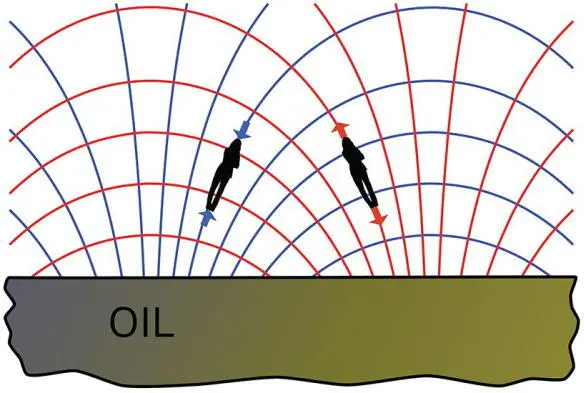
Fig. 24.6. Tendex lines above a portion of the Earth’s crust. The red lines produce a tidal stretch along themselves. The blue lines produce a tidal squeeze.
An instrument called a gravity gradiometer can measure these tidal patterns (Figure 24.7). It consists of two crossed, solid rods attached to a torsional spring. On the ends of each rod are masses that feel gravity. The rods are normally perpendicular to each other, but in the figure the blue tendex lines squeeze the top two masses together and squeeze the bottom two together, while the red tendex lines stretch the right pair of masses apart and stretch the left pair apart. As a result, the angle between the rods decreases until the spring counterbalances the tidal forces. This is the gradiometer’s readout, its “readout angle.”
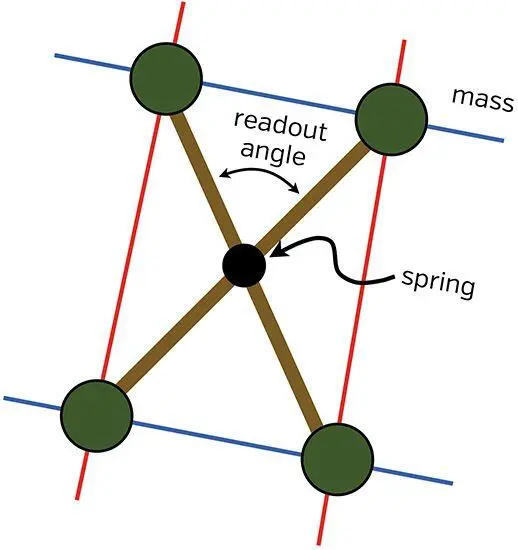
Fig. 24.7. A simple version of a gravity gradiometer, designed and built by Robert Forward at Hughes Research Laboratories in 1970.
If this gradiometer is flown rightward through the tidal pattern of Figure 24.6, its readout angle opens up above the oil-bearing region, and then closes down over the oil-free region. Gradiometers like this, but more sophisticated, are used by geologists to search for oil and also for mineral deposits.
NASA has flown a more sophisticated gradiometer called GRACE [40] The Gravity Recovery and Climate Experiment, a joint US/German space mission launched in May 2002 and still collecting data in 2014.
(Figure 24.8) to map tidal fields everywhere above the Earth, and watch slow changes of tidal gravity produced, for example, by the melting of ice sheets.
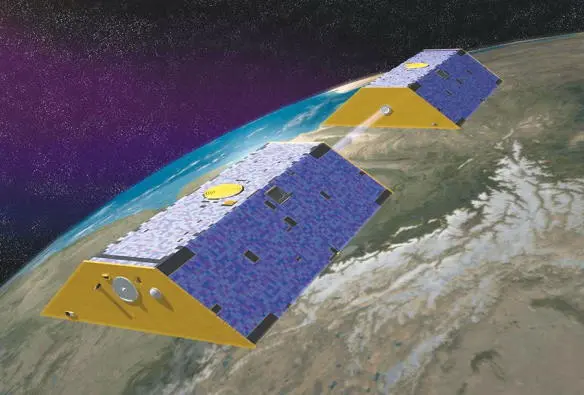
Fig. 24.8. GRACE: Two satellites, which track each other with a beam of microwaves, are pushed together by blue tendex lines and stretched apart by red tendex lines. The tendex lines, from the Earth below, are not shown.
In my interpretation of Interstellar , most of the gravitational anomalies that Professor Brand’s team measures are sudden and unexpected changes in the patterns of tendex lines above the Earth’s surface, changes that occur for no obvious reason. The rocks and oil in the Earth’s crust are not moving. The melting of ice sheets is much too slow to produce these quick changes. People see no new gravitating masses coming near the gradiometers. Nevertheless, the gradiometers report changing tidal patterns. Falling dust accumulates in radial lines. Cooper sees the coin plunge to the floor.
The members of Professor Brand’s team monitor these changing patterns and eagerly record Cooper’s observations. Their trove of data becomes grist for the Professor’s quest to understand gravity, a quest that centers on the Professor’s equation.
25
The Professor’s Equation

In Interstellar , the gravitational anomalies excite Professor Brand for two reasons. If he can discover their cause, that may trigger a revolution in our understanding of gravity, a revolution as great as Einstein’s relativistic laws. More important: If he can figure out how to control the anomalies, that could enable NASA to lift large colonies of people off the dying Earth, and launch them toward a new home elsewhere in the universe.
For the Professor, the key to understanding and controlling the anomalies is an equation he has written on his blackboard (Figure 25.7, below). In the movie, he and Murph struggle to solve his equation.
Murph’s and the Professor’s Notebooks—and the Blackboard
Before filming began, two impressive Caltech physics students filled notebooks with calculations about the Professor’s equation. Elena Murchikova filled a clean, new notebook with calculations by grown-up Murph, calculations written with elegant calligraphy. Keith Matthews filled a beat up, old notebook with calculations by Professor Brand, in the more sloppy handwriting common for old guys like the Professor and me.
Читать дальше
